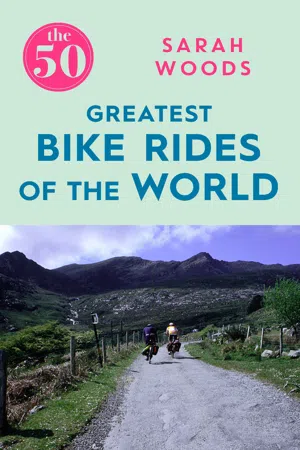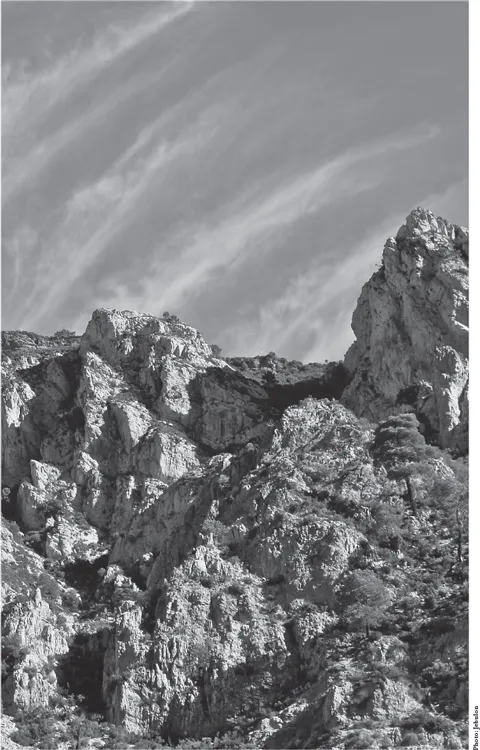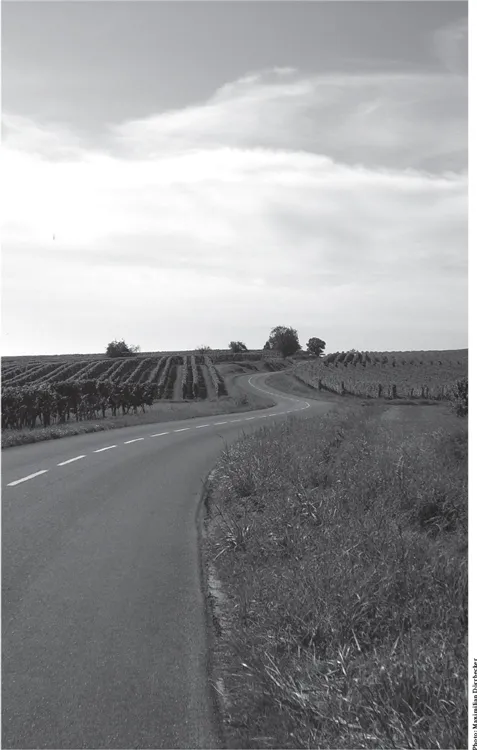
This is a test
- 304 pages
- English
- ePUB (mobile friendly)
- Available on iOS & Android
eBook - ePub
The 50 Greatest Bike Rides of the World
Book details
Book preview
Table of contents
Citations
About This Book
Imagine freewheeling through tufted French vineyards, scaling the rocky, cloud-topped tracks in the Himalayas or rattling past whitewashed sugar-cube houses in narrow Spanish valleys.From surviving the peaks of the Yorkshire Dales to tackling truly hair-raising descents in rural Cuba, the sheer variety of routes in The 50 Greatest Bike Rides of the World will have you reaching for your bicycle clips, helmet and gloves.Sarah Woods tells tales of scenic single tracks, switchback climbs and routes newly discovered from around the world, each with valuable tips and details to satisfy every cycling enthusiast.It's time to get those panniers packed and sprockets checked and to climb into the saddle.
Frequently asked questions
At the moment all of our mobile-responsive ePub books are available to download via the app. Most of our PDFs are also available to download and we're working on making the final remaining ones downloadable now. Learn more here.
Both plans give you full access to the library and all of Perlego’s features. The only differences are the price and subscription period: With the annual plan you’ll save around 30% compared to 12 months on the monthly plan.
We are an online textbook subscription service, where you can get access to an entire online library for less than the price of a single book per month. With over 1 million books across 1000+ topics, we’ve got you covered! Learn more here.
Look out for the read-aloud symbol on your next book to see if you can listen to it. The read-aloud tool reads text aloud for you, highlighting the text as it is being read. You can pause it, speed it up and slow it down. Learn more here.
Yes, you can access The 50 Greatest Bike Rides of the World by Sarah Woods in PDF and/or ePUB format, as well as other popular books in Personal Development & Travel. We have over one million books available in our catalogue for you to explore.
Information
Topic
Personal DevelopmentSubtopic
TravelEUROPE
SIERRA NEVADA, SPAIN
After a couple of days of blissful cycling in warm Spanish sunshine, things are about to get significantly more serious. Gradient signs in red are further emphasised by over-sized exclamation marks. My map looks alarming too: a spaghetti of tangled contour lines and elevations in a scary mix of colours. I gingerly approach the foothills of the Sierra Nevada and gradually allow myself to study the slopes beyond me. Dios mío! A slow-burning pain in my calves is fully registering on my radar and somehow it feels fitting that I should curse in the local lingo.
Like a puff of cloud, I’ve breezed along for an entire weekend feeling more than a little smug at the ease with which I progress. Now, however, I am developing a pathological hatred for my saddle, once relatively comfy but now an instrument of torture. I am also suffering from rather peculiar hazy hallucinations, no doubt prompted by the altitude. After navigating a succession of Volvo-sized potholes, I’m seriously tempted to sell my soul for just a few metres of asphalt. The Sierra Nevada’s legendary debilitating fatigue is already kicking in and bits of me are purple, red and blue: bruised, raw and saddle sore.
Give up? Not a chance: these aching limbs are well worth the rewards of two-wheeling the highest peak in Spain. A picnic of chorizo, olives, bread and cheese helps to revive my Photo flagging spirits as I pedal on high into the Sierra Nevada, leaving the steamy 36°C humidity-laden summer behind in favour of the clouds.
SIERRA NEVADA, SPAIN

Here it’s a glorious 25°C, with no wind to speak of. There isn’t much oxygen either at 3,000 metres (9,843 feet), so once the adrenaline-thrill of reaching the top subsides, an overwhelming sense of fatigue kicks in. Altitude can also play havoc with your emotions, coordination and judgement, so it’s best not to make any big life-changing decisions at the peak. Mentally, I make a note to avoid marriage proposals or honest calls to my boss, just in case my reasoning is skewed.
Like many other cyclists before me, I’ve limbered up on the valley slopes from the village of Capileira, the topmost settlement in the Poqueira Gorge. Picture-postcard wooden-beamed white-washed Alpujarran houses topple over narrow, winding streets. A road hemmed by varicoloured pot-plants climbs out of the village and looks out over rooftops dotted with pepper-pot chimneys to a stunning panorama. I contentedly pat the pedals to pass cactuses and lush, leafy vegetation before things toughen up and the road is swallowed up by piles of crumbling rocks.
Accommodation is offered by way of the Refugio del Poqueira, where I join a civilised bunch of hairy, bearded outdoor-types to overnight at 2,500 metres (8,202 feet). Over a sumptuous three-course meal of rabbit, complete with Andalusian wine, we swap tales of lunar-like dry river beds, forest trails and pea-soup fog, relishing every morsel.
Thanks to the scrambling hooves of mountain goats and a relay of contrabandistas, the Sierra Nevada boasts more well-formed single-track gully trails than they can shake an isotonic energy drink at – and all of it natural. Terrain ranges from sprouting farmland in the foothills through pine thickets to craggy barren peaks. Dry, dusty sinuous stretches dwindle to loosely scattered rocks in an instant with steep sandy ravines and nail-biting drops. Tangled roots and gnarled knotty creepers weave through skinny ferns and scrub on the unworldly trail up to Veleta – the second highest peak in Spain at 3,396 metres (11,142 feet) and a hellish climb along a chilly, windblown ridge where ledges of snow cling determinedly in sheltered crevices, even in August. Deeper drifts can force an undignified dismounting on the more dishevelled snow-crusted flanks, making it easier pride-wise to get off and walk. Then it’s a steady slog up through jagged, rock-scattered mayhem to Pico Veleta, where jaw-dropping views produce an involuntary intake of breath – all of it bug-free. It is here that I realise that my body has finally got used to the jolts and jars in the saddle, or has given up protesting about it. I imbibe the fragrance of damp mist and forest, gulp down several bottles of water and drink in the all-consuming quiet.
Next, it’s an epic three-in-one vertical descent at eye-popping velocity through the wilderness to Orgiva – not something for anyone who is gravity-shy. Picking a line between the rocks requires brow-furrowing concentration as I hurtle through nineteen kilometres (twelve miles) of desert – an exhilarating, downhill thrill at speeds of 40 kilometres per hour (25 miles per hour). The Sierra Nevada springs to life in the summer as wild flowers and herbs sprout up, spreading a colourful blanket and filling the air with scent. Tiny white-washed weather-beaten villages hug the mountainsides, while vultures and eagles swoop and soar in the thermals overhead.
Endurance level: Difficult
Tip: Save some stamina for the final leg – the climb is fearsome.
Contacts:
Biking Andalusia
www.bikingandalucia.com
Andalucia Tourist Board
www.andalucia.org
Spanish Tourist Board
www.tourspain.es
ANGOULÊME, FRANCE
A line drawn around the route of the Circuit des Remparts in the historic walled city of Angoulême forms an enticing squiggle packed with tight curves and wriggly switchback bends, linking the Cathedral St Pierre to the turn at Jerome Tharaud. This world-renowned classic car street race takes place on the third weekend in September each year, on a crowded circuit. Located about 45 minutes from Cognac, in the heart of the Charente district, Angoulême’s atmospheric ancient core – the Cité des Valois – is encircled by imposing ramparts and a riddle of climbing, narrow roads. On race day, amidst a flurry of brightly coloured flags and bunting, the historic quarter closes off to form a highly demanding street circuit. Highly polished classic cars gleam in anticipation at the start-line, from the Bugatti, Riley and MG racers of the pre-war category to post-war Porsche 911s and TVRs. Angoulême’s fearsome combination of hairpin bends and lightning-fast straights requires spine-tingling driving precision. Cars roar past crowds of spectators just a few inches from grand medieval buildings that provide a spectacular throwback to bygone years. Handsome solid stone walls do much to enhance the drama as the resonating blasts of vintage exhausts hail the start of one of the most perilous races on the planet.
On a bike, even a brand new alloy model, I’m unlikely to clock up eye-popping speeds on the per-lap distance of 1.279 kilometres (0.795 miles). However, I will get to feel the gravity of the right-angle bends and tight twists and turns of this extraordinary race course. As a competitive cycle sprint route, guided by ramparts of the city, it is an easy to navigate fast-paced dash that takes some beating. Almost two-thirds of the route runs atop the city to offer striking views of the scenery beyond, while the statuesque cathedral provides an imposing start/finishing line. As a motor sports route, the Angoulême International Circuit des Remparts is the only inner city racing circuit whose layout has remained unchanged since it was created in 1939.
To achieve a decent time as I race around Angoulême’s tight, switchback bends, I revisit some of the fundamentals of my basic cycling technique. On a route like this, the pedalling, gearing and braking need to be so smooth and fluid as to be imperceptible. My hips should be still, my cadence steady and I should feel at one with my bike. The thing about bike-handling is that it requires plenty of practice to master it. In my head I will myself to be more like Bradley Wiggins, with his effortless glide and oh-so-seamless cornering. To ride the Circuit des Remparts route well is to ride with cool, calm confidence, otherwise I risk leaving a lot of skin on the road. In readiness, I get on the drops with my fingers on the brakes to maximise traction and control. I also level myself out on the saddle to ensure the distribution of my body weight is even between the front and rear tyres. I wobble, alarmingly, so resolve to go steady. I shift my weight to the outside leg so I can cut a tighter line. Uneven road surfaces and bumps, potholes and traffic are all hazards on the route and I am poised to keep an eagle eye out for manhole covers and road markings. One of my worst traits is braking too hard, which on this route could cause my bike to skid. There are few opportunities to straighten out a corner along the track in Angoulême, so I will need to slow right down before the death-defying turn on the lung-busting homeward stretch.
ANGOULÊME, FRANCE

On the day I’m in Angoulême, I’m joined on the circuit by a time trial veteran from Canada and a Spaniard on a racing trike. Cyclists often visit Angoulême’s Circuit des Remparts as they pass through Charente while on the EuroVelo network (otherwise known as the Pilgrims Route). Created from fourteen cycling routes that stretch across Europe, the 5,122-kilometre (8,182-mile) Pilgrims Route connects Trondheim in Norway to Saint Jacques de Compostela in Spain. The Canadian, Spaniard and I decide to attempt the Circuit des Remparts together and I’m grateful for the companionship along a particularly challenging series of frightening dog-legs that scale the ramparts on a gradient. We reach a tearing pace towards an imaginary black-and-white-chequered flag. It may be a far cry from lap speeds of 70 kilometres per hour (43.5 miles per hour) achieved by the likes of Porsche and Bugatti, but it is still deserving of the traditional Angoulême winner’s lap of honour – which we deliver, the two wheeled way.
Endurance level: Moderate
Tip: Wear bright clothes along this bendy route – visibility is all-important on the blind switchbacks.
Contacts:
Circuit International des Remparts d’Angoulême
www.circuit-des-remparts.com
Charente Tourist Board
www.visit-poitou-charentes.com
ROUTE DES VINS, FRANCE
The scenery may be postcard picturesque, but don’t let the genteel charm of the Route des Vins deceive you: discovering Alsace on two-wheels requires a slog along a long and wineding road. Top-notch athletes with a fervent enthusiasm for the saddle will find the gentle, sloping stretches a breeze. Yet, in the unrelenting searing summer heat, the route’s shadeless climbs are a gruelling test of endurance. Thankfully, a scattering of rustic stone water-fountains offer panting cyclists much-needed irrigation. Few things are as thrilling as free-wheeling downhill at speed just a stone’s throw from Germany and the Rhine, past 119 half-timbered villages in a rainbow of bubble-gum hues.
Although it’s possible to cycle from Strasbourg itself, the city’s traffic-heavy streets and suburbs are worth giving a miss. Instead, head to the pretty stone villages around handsome Blienschwiller about 39 kilometres (24 miles) to the northwest. The entire Wine Route stretches some 170 kilometres (106 miles) from Gimbrett in the north to Leimbach in the south, a stretch doable in a long weekend. A shorter burst from Blienschwiller to Riquewihr is about a 60-kilometre (37-mile) round trip – hardly the Tour de France, admittedly, but almost all of it congestion-free. Yet with the blue-green Vosges Mountains and the crags of the Black Forest as distractions – not to mention 7,000 winegrowers and 14,500 hectares (35,830 acres) of vines – choosing to do a more intense, cherry-picked snapshot of the Route des Vins is an excellent option for those up against the clock.
ROUTE DES VINS, FRANCE

More than 8 million visitors make the pilgrimage to the Wine Route each year, not all of them by bike. Those who do, however, will experience some of France’s most stunning countryside along with plenty of challenges to conquer. Most tour companies deliver bikes to your door, spokes and sprockets checked and tyres fully pumped. Then, simply unfurl a map to gauge the physical demands ahead: the spaghetti riddle of wiggly lines is testament to an upcoming series of hills. An initial easy stretch through Dambach-la-Ville, Dieffenthal, Scherwiller, Kintzheim and Châtenois eases cyclists into the saddle, but is merely a light appetiser for a meatier entrée. Yellow-green vines and red-roofed cottages form a checkerboard landscape, dotted with Gothic spires and turrets. Forests, ramparts and ancient ruins are surrounded by meadows of sweet-smelling wildflowers. It is impossible not to become lost in the rush of scenery as the kilometres whiz by, such is the heady freedom of Alsace’s vine-hemmed open roads. Rorschwihr, a small hamlet, lays down the first gauntlet. It’s a skyward climb, prompting a gripping of handlebars, lowering of head and gritting of teeth as the pedals are pounded with vigour. Rows of proud saluting vines greet the sweat-beaded triumphant. In summer, a field of beaming, weathered farm-workers are also prone to imparting words of advice on the quirks of the road ahead.
Freewheeling through Kintzheim and Orschwiller and out towards Saint-Hippolyte allows a chance for the adrenaline to surge as the speedometer hits the max. Towards Rorschwihr the road widens and becomes busier as farm trucks and tractors chug past followed by a stream of slow-moving cars. One hilly kilometre leads to another, yet the constant visual stimulation of the magnificent Wine Route’s vine-clad contours helps dull the pain of tiring limbs. Another source of motivation is the super-fit professional road-racing cyclists who favour the route, whooshing by effortlessly, legs waxed and oiled. Competitive types will find that just the sight of such an über human can trigger an incredible surge in natural power, sparking an energetic out-of-the-saddle sprint in pursuit of a moving cloud of dust on the horizon.
From Ror...
Table of contents
- Copyright Page
- About The Author
- Contents
- Introduction
- The 50 Greatest Bike Rides of the World
- United Kingdom and Ireland
- Europe
- Asia
- Australasia
- The Americas
- Africa
- Back Cover